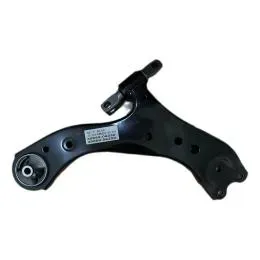.jpeg)
You are driving down a winding road, smoothly gliding over bumps and dips without a care in the world. What makes this seamless ride possible? The suspension control arm is an often overlooked yet crucial component of your vehicle's suspension system.
Suspension Control Arm Basics
At its core, the suspension control arm, also known as an A-arm or wishbone, is a vital link between the vehicle's chassis and the wheel assembly. It serves as a pivotal connection point, allowing the wheel to move up and down while maintaining proper alignment with the road surface. The suspension control arm plays a pivotal role in absorbing shocks and vibrations, providing stability during cornering, and supporting the weight of the vehicle.
Suitable For Toyota Crown Under Track Control Arm 48640-0n010,43620-0n010
Anatomy of a Suspension Control Arm
A typical suspension control arm consists of several key components, including:
Arm Body
The main structural component of the control arm, typically constructed from stamped steel, aluminum alloy, or forged steel for strength and durability.
Bushings
These rubber or polyurethane inserts dampen vibrations and allow for controlled movement of the control arm.
Ball Joints
Found at both ends of the control arm, ball joints provide articulation and rotational movement, allowing the wheel to steer and maintain alignment.
Mounting Points
The control arm is securely attached to the vehicle's frame or subframe at one end and the wheel hub or knuckle at the other end.
How Does a Suspension Control Arm Work?
During normal operation, the suspension control arm undergoes dynamic movement as the vehicle encounters bumps, potholes, and uneven road surfaces. When the wheel encounters an obstacle, the control arm flexes and pivots, absorbing the impact and allowing the wheel to move vertically while maintaining optimal contact with the road. This controlled movement is essential for maintaining traction, stability, and passenger comfort.
Upper and Lower Control Arms
Vehicles equipped with double-wishbone or multi-link suspension systems often have upper and lower control arms. The upper control arm typically connects the top of the steering knuckle to the vehicle's frame or body structure, while the lower control arm connects the bottom of the knuckle to the frame or subframe. Together, these control arms provide stability, control, and flexibility in the suspension system.





















































































































 English
English  Afrikaans
Afrikaans  Albanian
Albanian  Amharic
Amharic  Arabic
Arabic  Armenian
Armenian  Azerbaijani
Azerbaijani  Basque
Basque  Belarusian
Belarusian  Bengali
Bengali  Bosnian
Bosnian  Bulgarian
Bulgarian  Catalan
Catalan  Cebuano
Cebuano  Corsican
Corsican  Croatian
Croatian  Czech
Czech  Danish
Danish  Dutch
Dutch  Esperanto
Esperanto  Estonian
Estonian  Finnish
Finnish  French
French  Frisian
Frisian  Galician
Galician  Georgian
Georgian  German
German  Greek
Greek  Gujarati
Gujarati  Haitian Creole
Haitian Creole  Hausa
Hausa  Hawaiian
Hawaiian  Hebrew
Hebrew  Hindi
Hindi  Miao
Miao  Hungarian
Hungarian  Icelandic
Icelandic  Igbo
Igbo  Indonesian
Indonesian  Irish
Irish  Italian
Italian  Japanese
Japanese  Javanese
Javanese  Kannada
Kannada  Kazakh
Kazakh  Khmer
Khmer  Rwandese
Rwandese  Korean
Korean  Kurdish
Kurdish  Kyrgyz
Kyrgyz  Lao
Lao  Latin
Latin  Latvian
Latvian  Lithuanian
Lithuanian  Luxembourgish
Luxembourgish  Macedonian
Macedonian  Malgashi
Malgashi  Malay
Malay  Malayalam
Malayalam  Maltese
Maltese  Maori
Maori  Marathi
Marathi  Mongolian
Mongolian  Myanmar
Myanmar  Nepali
Nepali  Norwegian
Norwegian  Norwegian
Norwegian  Occitan
Occitan  Pashto
Pashto  Persian
Persian  Polish
Polish  Portuguese
Portuguese  Punjabi
Punjabi  Romanian
Romanian  Russian
Russian  Samoan
Samoan  Scottish Gaelic
Scottish Gaelic  Serbian
Serbian  Sesotho
Sesotho  Shona
Shona  Sindhi
Sindhi  Sinhala
Sinhala  Slovak
Slovak  Slovenian
Slovenian  Somali
Somali  Spanish
Spanish  Sundanese
Sundanese  Swahili
Swahili  Swedish
Swedish  Tagalog
Tagalog  Tajik
Tajik  Tamil
Tamil  Tatar
Tatar  Telugu
Telugu  Thai
Thai  Turkish
Turkish  Turkmen
Turkmen  Ukrainian
Ukrainian  Urdu
Urdu  Uighur
Uighur  Uzbek
Uzbek  Vietnamese
Vietnamese  Welsh
Welsh  Bantu
Bantu  Yiddish
Yiddish  Yoruba
Yoruba  Zulu
Zulu